Castlerigg Stone Circle : Great Stone Project 2022
I arrived at Castlerigg Stone Circle late evening on 12th June 2022, light rain falling on the mountains as I pulled into a layby. Although these were the first stones on this trip, they were not the first in this erstwhile project, not that I had any idea initially it would become a project. Several months before I had visited a Henry Moore sculpture exhibition in Bruton, where his inspiration from the stones at Stonehenge was explored and his wonderful drawings of the trilithons exhibited. It was clear in his scultpures and drawings he had drawn massively from the ancient standing stones of our forebears.
Following that exhibition, I had visited the relatively nearby stones at Stanton Drew, and then visited Avebury several days later. Both of those trips are documented in earlier blog posts.
I had then decided to visit the circles in Scotland and the southwest of England, journeying up through the islands of Arran, Barra, the Uists, Harris and Lewis, before driving onto Orkney. As the plan developed in my head, so my scope increased and intensified, wondering just how wide I could interpret the notion of stone and landscape. I began wondering how to achieve this. And how to portray them as being alive.
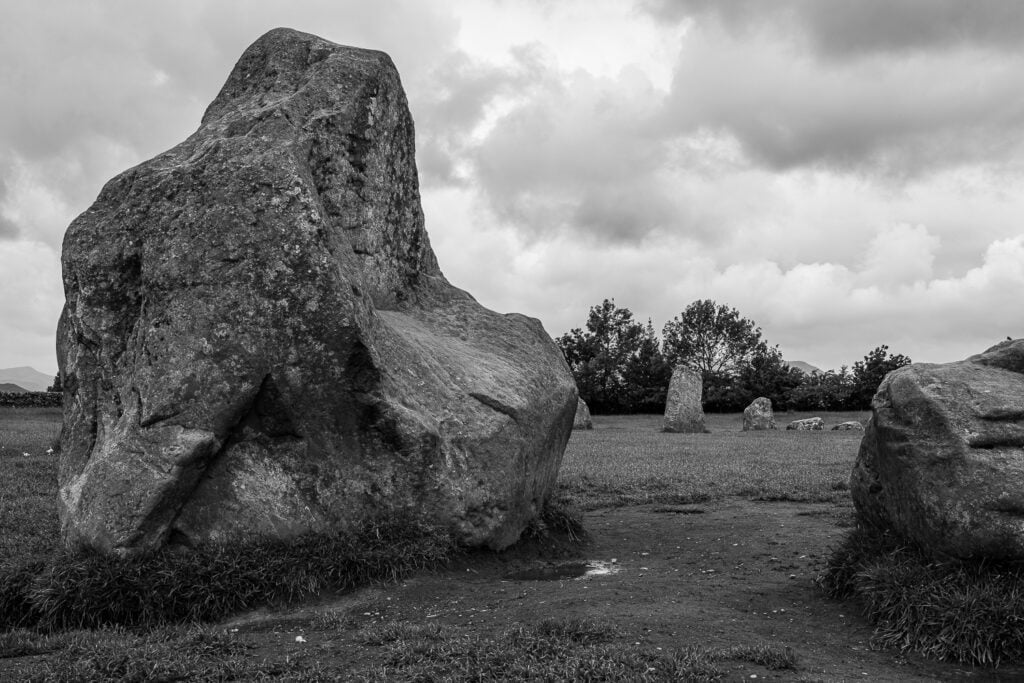
The rain became heavier and I had to wait to explore them with my camera. Eventually, at dusk, the rain relented and I was able to move amongst the stones.
The location is a kind of natural ampitheatre, a space surrounded by the Cumbrian mountains. It is undoubtedly ancient. I managed to take some photographs, one of which is the bottom photograph here, the only colour image in this spread. The clouds were hanging low, and it was a natural image for a monochrome rendition, but the muted softness of the colour appealed and it remained a colour photograph.
The remainder of the photographs were taken the following day in brief episodes of better light. Cloud formations were to become a feature of this trip; the north of the UK is nothing if not enshrouded in cloud.
What was the appeal of stones to me? I had been visiting them for many years of my life and always experienced feelings similar to those I experience when I enter a cathedral. Alignments and other scientic explanations never had resonance. It was always something else.
By the end of the morning I was ready to move on and into Scotland.
The question remained about how to best present the visited landscapes and the stones as being more than inert.
Details of Castlerigg
- Castlerigg is set 213m (700ft) above sea level. It is thought to be one of the earliest circles in Britain, and it dates from around 3,200 BC. (2)
- Castlerigg is one of the most dramatically situated circles in England with views of the Cumbrian mountains on all sides.
- The circle is important to archaeo-astronomers who have noted that the sunrise during the Autumn equinox appears over the top of Threlkeld Knott, a hill 3.5 km to the east. Some stones in the circle have been aligned with the midwinter sunrise and various lunar positions.
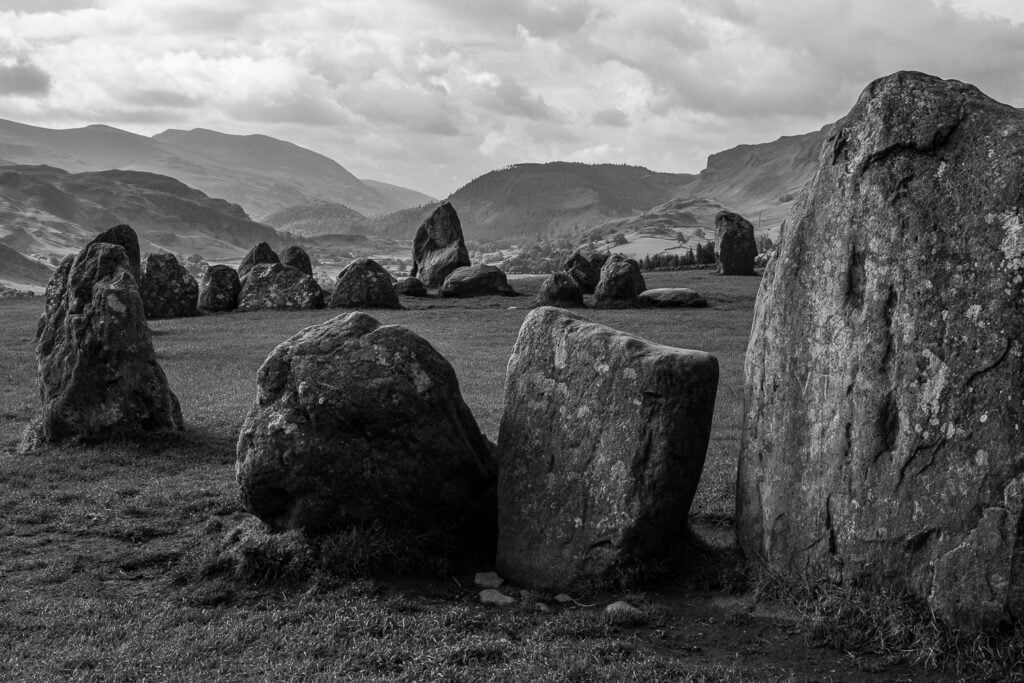
- Castlerigg sits on an ancient track from Borrowdale, a source of stone for axes. The ring has a flattened arc at the north-east. It also has an entrance defined by two two tall stones flanking the gap at the exact north. Around the circumference are traces of a bank.
- Thirty-eight stones are placed in an slightly oval shape of 30m (100ft) in diameter; a further 10 small stones are arranged as a rectangular enclosure on the south-east side of the ring: this is a feature unique to Castlerigg, nothing similar being present in other stone circles.
- The largest stone of the circle, not far from the enclosure, is 2.5m (8ft 3in) high and it weighs about 16 tons: most of the others, much smaller, are 1 to 1.5m (3-5ft) high. At the north of the ring is an entrance marked by two slightly bigger stones, and about 90m (295ft) to the south-west, by a stile at the edge of the field, is a single outlying stone, 0.9m (3ft) high.
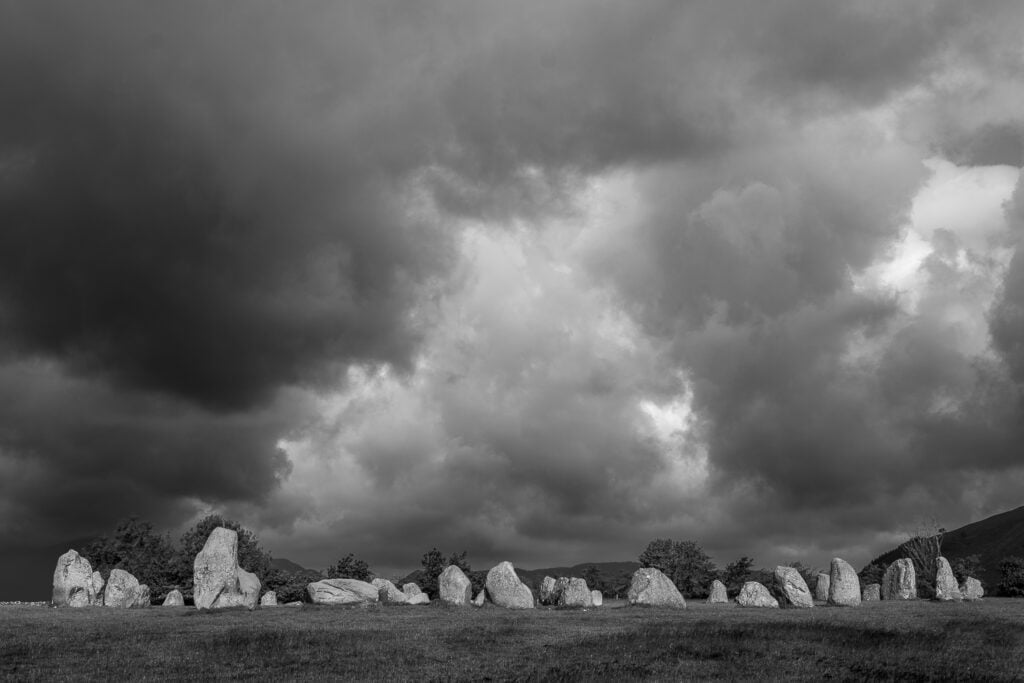
- There are many theories about Castlerigg’s function. In Professor Alexander Thom’s opinion, the circle was an astronomical observatory, while Professor Aubrey Burl wrote that one of Castlerigg’s many functions may have been to act as an emporium connected with the Neolithic stone axe industry in the Langdales. The close mountainous source of the tuff used for such tools and the stone axes found at the site support this theory. Probably, Castlerigg had a variety of functions: easily approached from all directions, it was probably used for trading, religious ceremonies, and tribal gathering. The rectangular enclosure was excavated in 1882, and only charcoal was found. No other excavation has taken place, either within the enclosure or outside.
- The Stone circle at Castle Rigg, Cumbria was one of the most successful that Alexander Thom came across in terms of combining astronomical sight-lines with the geometric construction of the stone circle itself. Thom himself pointed out the remarkable difficulties in trying to find a site where the skyline yielded the exact right properties to match the astronomic requirements and geometry of the circle itself. Although the geometric connections with the landscape are not immediately visible today, it has become clear that the builders were endeavouring to express, control or ‘come to terms with something’. In addition, J. Glover made some interesting comments regarding Castle Rigg, namely that the specific placement of certain stones enhanced the shadow-effects caused by the sun at specific times of the year. As the circle was built onto a gentle slope, the largest stone creates a shadow nearly a half-mile long at sunset on midsummer’s day.

- The site was first brought to public notice in 1725 by the antiquarian William Stukeley, who wrote that the circle was very entire, consisting of 50 stones, some very large. But in 1849, in his Guide to The Lakes, Jonathan Otley reported the present total of stones. Castlerigg, known to local people as Druid’s Circle, is also called Keswick Carles, apparently because of an old legend telling that the stones are petrified men, but in fact for a misunderstanding of William Stukeley’s word Carles for Castle. William Stukeley�s account of his visit to Castlerigg was published in his Itinerarium Curiosum in 1776, 11 years after his death. Stukeley�s visit is important, as it is the earliest written record of the stone circle at Castlerigg:
- �for a mile before we came to Keswick, on an eminence in the middle of a great concavity of those rude hills, and not far from the banks of the river Greata, I observed another Celtic work, very intire: it is 100 foot in diameter, and consists of forty stones, some very large. At the east end of it is a grave, made of such other stones, in number about ten: this is placed in the very east point of the circle, and within it: there is not a stone wanting, though some are removed a little out of their first station: they call it the Carsles, and, corruptly I suppose, Castle-rig. There seemed to be another larger circle in the next pasture toward the town. (Stukeley 1969 Vol. II, 48).
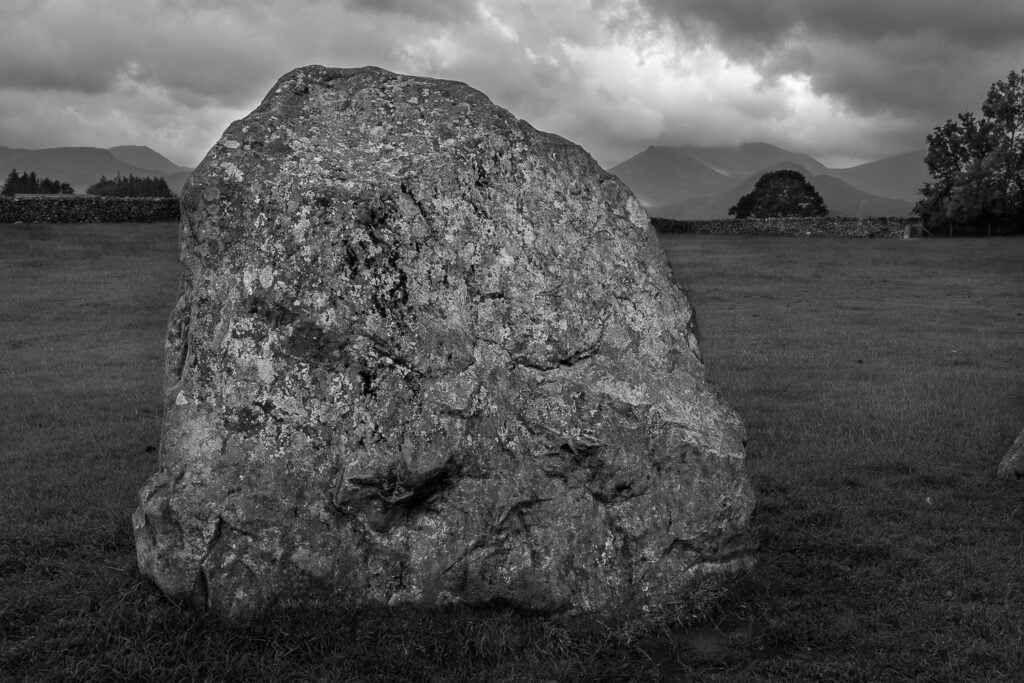
- In the early 20th century, a single outlying stone was erected by a farmer approximately 90m to the south west of Castlerigg. This stone has many linear �scars� along its side from being repeatedly struck by a plough, suggesting that it was once buried below the surface and also why the farmer dug it up. It is not possible to say whether this stone was originally part of the circle, or just a naturally deposited boulder.
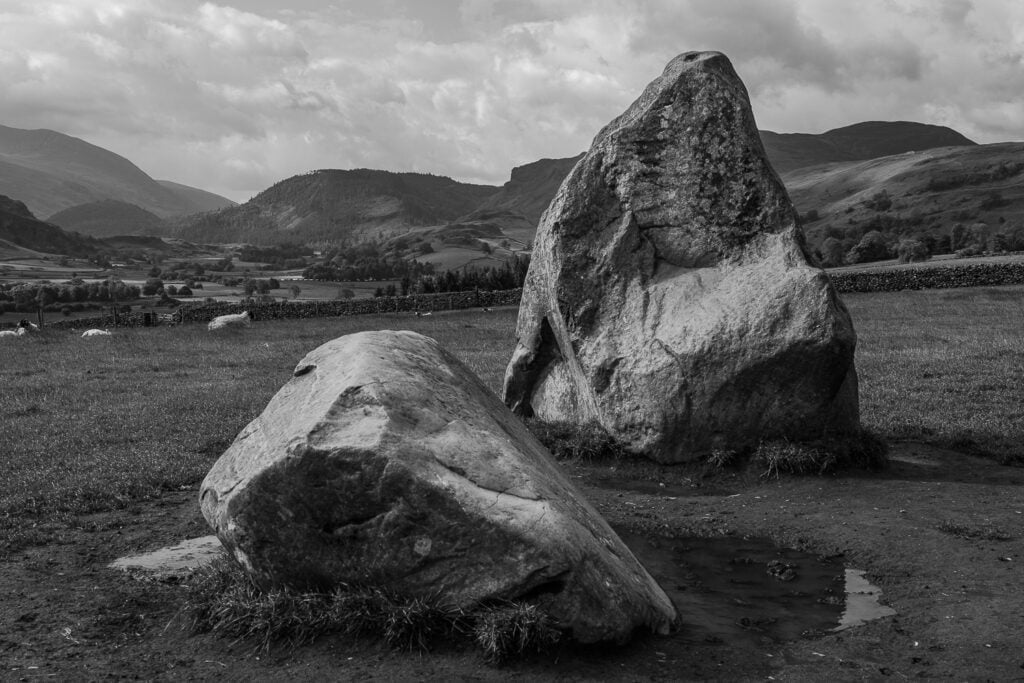
Alignments:
- Professor Alexander Thom’s believed that the circle was an astronomical observatory with the tallest stone (right), being in line with the November or Samhain (Candlemas) sunrise.
- At Castle Rigg, the artist and earth mysteries researcher, John Glover noted that:
“One of the four alignments defined by the construction lines of the circle reveals the feat of indicating two solar events in the Neolithic calendar at opposite ends of the alignment.; the midsummer setting sun and the Candlemas rising sun. This is made possible by the geometry. Astoundingly, the builders have made use of another natural feature along this alignment.
At midsummer’s day, the sun appears to set at an angle formed by the large stone of the alignment and the ridge of Latrigg away to the west. The exact point of the sunset appears to ave been marked by one of the mounds on that ridge. If at the time of the sunset, having positioned yourself behind the large stone, you turn around 180� to face the Candlemas alignment, ‘shadow path’ as I have termed it, stretches out before you...” (21).
- The Castle Rig alignment runs for about 5miles, and along that line, there are at least ten points of significance: The mound, the first small stone of the circle, the centre point of the circle where a buried stone has been found the group of small stones in the cove, the large stone, its shadow path, the spring, a possible standing stone, a high point on the ridge in the middle distance by Low Rigg, a holy well dedicated to St. John, another high point above this, and a the final; notch formed by a river valley high up on St. Johns common near Little Dod.
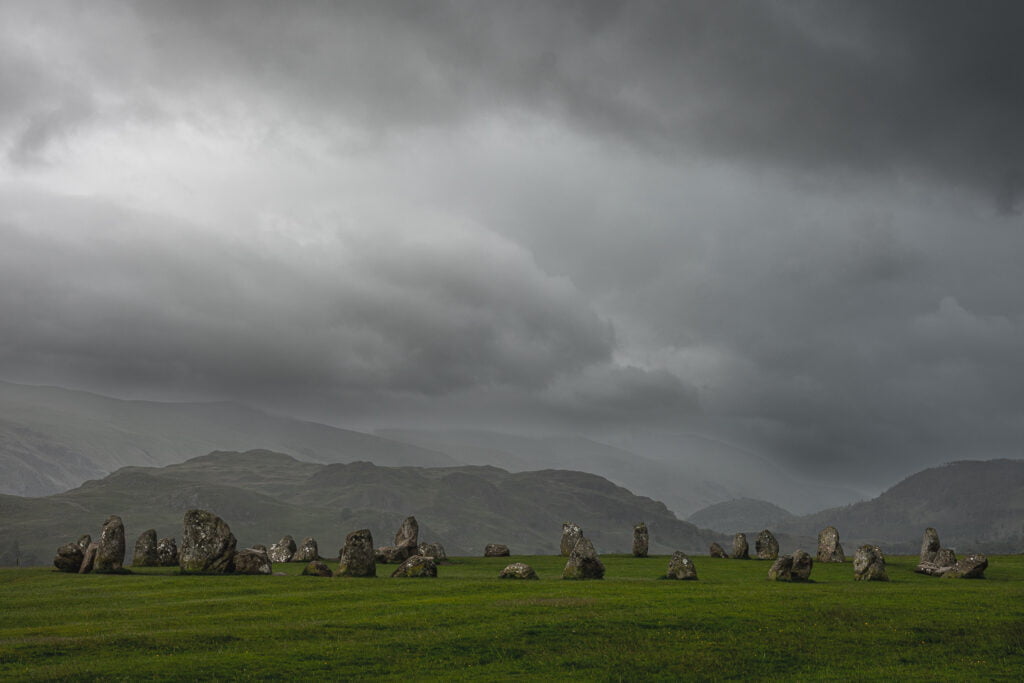
Details about Castlerigg Stone Circle were taken from